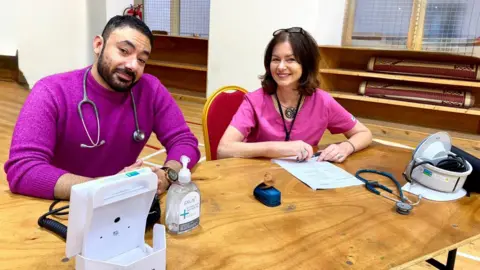Diabetes scheme reduces risk of condition by quarter
 BBC
BBCA diabetes prevention programme in Wales could reduce the risk of developing the condition by nearly a quarter, research has shown.
But the all-Wales programme "doesn't currently live up to its name" as it only operates in parts of Wales, a charity said.
Diabetes affects more than 220,000 people in Wales with projections it could rise by 22% over the next decade.
Rachel Burr, head of Diabetes UK Cymru, said NHS costs had also risen and called for money to be invested in patients before they start to live with the condition.
The Welsh government said funding has been allocated this year to make further progress in embedding delivery in core activity and rolling it out across Wales.
Following a pilot in two parts of Wales, in 2022 the gradual roll out began with 35 of the 60 primary care clusters in Wales, prioritising areas in each health board with a high prevalence of type 2 diabetes.
Funded by the Welsh government but provided by health boards, it has now been offered to more than 10,000 people across Wales.
"So many people in Wales will not have access to this programme currently and that's an inequity – its not fair," said Ms Burr.
"We want everyone to have access to the same level of support and care because diabetes is such a serious condition.
"It's actually at crisis levels in Wales and continuing to rise and we need to make sure we're getting people the help they need before they develop diabetes if possible."
 Swansea Bay University Health Board
Swansea Bay University Health BoardDavid Weekes from Swansea has been among those to benefit from the prevention programme.
The 67-year-old only discovered he was pre-diabetic when he went to the GP about an unrelated rash on his knees, and was sent to see the prevention team in Penclawdd.
"We talked about my diet and exercise and I went back for a follow-up appointment this year," he said.
"In that time I have lost 2st 1lb (13kg). I stopped eating as many biscuits and cakes and I now go to the gym every day.
"I feel a lot better in myself for doing it and my glucose levels have come right down."
Ms Weekes said while he was not unfit before, it gave him the warning "I needed".
"I now cycle seven days a week, for about 15-16 miles (25km), and I do weightlifting in the gym."
 Swansea Bay University Health Board
Swansea Bay University Health BoardThe scheme uses a blood test, called an HbA1c test, to identify those at increased risk of developing type 2 diabetes by measuring their average blood sugar levels.
Those with levels between 42-47 millimoles per mole are classed as at increased risk and offered a 30-minute appointment with a healthcare support worker, where information and support is provided.
A follow up appointment then takes place a year later.

Dr Sarah Davies, a GP in Cardiff and primary care lead for diabetes in Wales, said blood tests would often identify someone is borderline for type 2 diabetes, but "until now we haven't had anywhere we can refer those individuals to get that support".
"Primary care is on our knees and under-resourced across Wales. So sometimes those patients haven't received much in the way of information about pre diabetes.
"That's why I so welcome this program to enable us to refer these individuals into a community service.
"I'm hoping now that we've got this study that clearly demonstrates the benefits, this will support more widespread funding for this innovative program here in NHS Wales."
She added that patients sometimes feel shame attached to being told they are pre-diabetic.
"There's a lot of blame associated with it, which is not the case. There's many reasons why people end up living with overweight, obesity and at risk of type two diabetes, many complex environmental, genetic reasons.
"So sometimes people don't want to face up to it, but actually giving one to one support via this program is a lovely way to be able to give an individualized approach."
Alisha Davies, head of research and evaluation at Public Health Wales, said results have shown the programme has been been effective in "stalling and reducing progression" to diabetic blood glucose levels.
She said "robust monitoring and evaluation" will help to understand its impact over time on "an important preventable disease in Wales".
 Swansea Bay University Health Board
Swansea Bay University Health BoardStaff from one primary care cluster in Swansea have also taken the screening to a local mosque to identify those who are either pre-diabetic or have undiagnosed diabetes.
Dr Wynn Burke said: "Our practice population includes a significant Asian community who are known to be at higher risk of diabetes from a much younger age.
"We do a lot of diabetes screening in high-risk individuals as part of our normal practice.
"However, the percentage of our practice population with a diagnosis of type 2 diabetes remains below the expected ratio, therefore we sought to reach out and bridge potential health inequalities."
Caroline Ashwood, an advanced nurse practitioner at SA1 Medical Centre, said around a fifth of the 140 people screened over three days so far had been identified as pre-diabetic, and three had diabetes.
"Swansea Mosque is based within our (cluster area), and it is one of the largest in the UK with around 10,000 members, so this was a great opportunity to bridge health inequalities," she said.
"The team at Swansea Mosque were equally proactive in working together. They set up the online booking system and supported us on the screening days we have already carried out."
The Welsh government said: "We know preventative support makes a real difference in reducing the risk of people with prediabetes developing type 2 diabetes, and funding from a variety of sources has been used to develop and extend the programme.
"To ensure more people across Wales can benefit from early support, funding has also been allocated this year to make further progress in embedding delivery in core activity and rolling out across Wales."
How many people have diabetes in Wales?
There are more than 220,000 people in Wales with diabetes – predominantly with type 2 which is preventable – and the numbers have steadily risen in Wales.
Projections by Public Health Wales (PHW) suggest that without intervention, by 2035 there will be a 22% rise in those numbers.
The figures are higher among older people and men, though Diabetes UK Cymru said they were seeing more cases of people under 40 developing the condition.
PHW research shows the cost and volume of medicines prescribed for diabetes has been steadily increasing over the last decade.
The cost of medicine ingredients alone has risen 56% in the last five years and is now over £90m in Wales, partly because of the increase in the numbers of items prescribed.
There were also 90,000 hospital admissions attributed to diabetes in Wales during 2021/2022.
What is type 2 diabetes?
Type 2 diabetes is where the body does not produce enough insulin, or the body's cells do not react to insulin properly.
Healthy eating, regular exercise and a healthy body weight reduce the risk of developing it.
The condition can cause excessive thirst, tiredness and the need to go for a wee a lot. It can also lead to complications like heart disease, stroke, kidney disease, retina damage and foot problems if not managed well.
